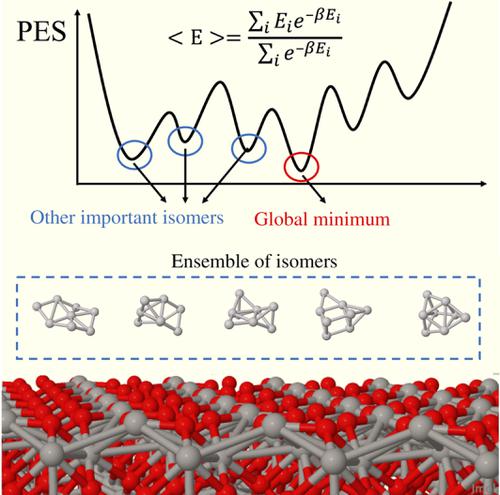当前位置:
X-MOL 学术
›
WIREs Comput. Mol. Sci.
›
论文详情
Our official English website, www.x-mol.net, welcomes your feedback! (Note: you will need to create a separate account there.)
Surface‐supported cluster catalysis: Ensembles of metastable states run the show
Wiley Interdisciplinary Reviews: Computational Molecular Science ( IF 11.4 ) Pub Date : 2019-05-28 , DOI: 10.1002/wcms.1420 Borna Zandkarimi 1 , Anastassia N. Alexandrova 1, 2
Wiley Interdisciplinary Reviews: Computational Molecular Science ( IF 11.4 ) Pub Date : 2019-05-28 , DOI: 10.1002/wcms.1420 Borna Zandkarimi 1 , Anastassia N. Alexandrova 1, 2
Affiliation

|
It has recently been shown that the dynamic behavior of surface‐supported nanocluster catalysts in realistic reaction conditions defies conventional models used in catalysis. This opens new doors in catalysis by giving more leverage in catalyst design, but also requires a major revision of the understanding of how dynamic heterogeneous catalytic interfaces operate, as well as of the computational approaches of catalyst modeling, and experimental methods of catalyst characterization. Major aspects of the new paradigm include the collective action of many catalyst states that form a statistical ensemble in reaction conditions, the catalytic activity and selectivity being driven by rare and metastable catalyst states, reaction thermodynamics and kinetics being controlled by different states of the catalyst, broken scaling relationships, non‐Arrhenius behaviors, and catalyst dynamic restructuring being an essential part of the reaction mechanism. For computation, this complexity means the departure from the standard density functional theory calculations of reaction mechanisms on a single catalyst structure. For experiment, it calls for the development of operando characterization tools with the per‐site resolution and the ability to find the minority sites that govern the catalytic activity. For catalyst design, the goal becomes the creation of the catalyst state (geometric and electronic) that might not be present in the as‐prepared catalyst, but would develop in the reaction conditions and would have the desired activity then. While cluster catalysts are the most dramatic in their dynamic fluxionality, other amorphous interfaces also exhibit some of it, and thus are also subject to similar paradigm revision.
中文翻译:

表面支持的团簇催化:亚稳态的集合体参与了此次展览
最近发现,表面负载的纳米簇催化剂在实际反应条件下的动力学行为违背了催化中使用的常规模型。通过在催化剂设计中发挥更大的杠杆作用,这为催化领域打开了新的大门,但同时也需要对动力学非均相催化界面的运作方式,催化剂建模的计算方法以及催化剂表征的实验方法的理解进行重大修订。新范式的主要方面包括在反应条件下形成统计集合的许多催化剂状态的集体作用,稀有和亚稳态催化剂状态驱动催化活性和选择性,催化剂的不同状态控制反应热力学和动力学,破坏的缩放关系,非阿累尼乌斯行为,催化剂动态重组是反应机理的重要组成部分。为了进行计算,这种复杂性意味着偏离了单一催化剂结构上反应机理的标准密度泛函理论计算。为了进行实验,它要求开发具有每个位点分辨率的操作表征工具,并能够找到控制催化活性的少数位点。对于催化剂设计,目标是创建可能不存在于准备好的催化剂中但会在反应条件下发展并具有所需活性的催化剂状态(几何和电子)。虽然簇状催化剂的动态通量最引人注目,但其他无定形界面也表现出某些特征,因此也经历了类似的范式修订。
更新日期:2019-05-28
中文翻译:

表面支持的团簇催化:亚稳态的集合体参与了此次展览
最近发现,表面负载的纳米簇催化剂在实际反应条件下的动力学行为违背了催化中使用的常规模型。通过在催化剂设计中发挥更大的杠杆作用,这为催化领域打开了新的大门,但同时也需要对动力学非均相催化界面的运作方式,催化剂建模的计算方法以及催化剂表征的实验方法的理解进行重大修订。新范式的主要方面包括在反应条件下形成统计集合的许多催化剂状态的集体作用,稀有和亚稳态催化剂状态驱动催化活性和选择性,催化剂的不同状态控制反应热力学和动力学,破坏的缩放关系,非阿累尼乌斯行为,催化剂动态重组是反应机理的重要组成部分。为了进行计算,这种复杂性意味着偏离了单一催化剂结构上反应机理的标准密度泛函理论计算。为了进行实验,它要求开发具有每个位点分辨率的操作表征工具,并能够找到控制催化活性的少数位点。对于催化剂设计,目标是创建可能不存在于准备好的催化剂中但会在反应条件下发展并具有所需活性的催化剂状态(几何和电子)。虽然簇状催化剂的动态通量最引人注目,但其他无定形界面也表现出某些特征,因此也经历了类似的范式修订。


























 京公网安备 11010802027423号
京公网安备 11010802027423号